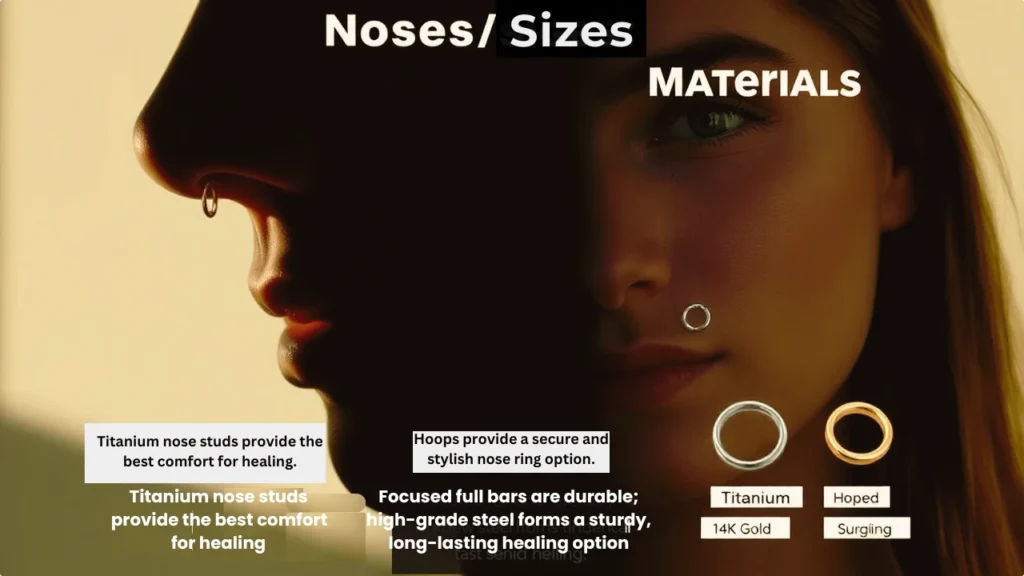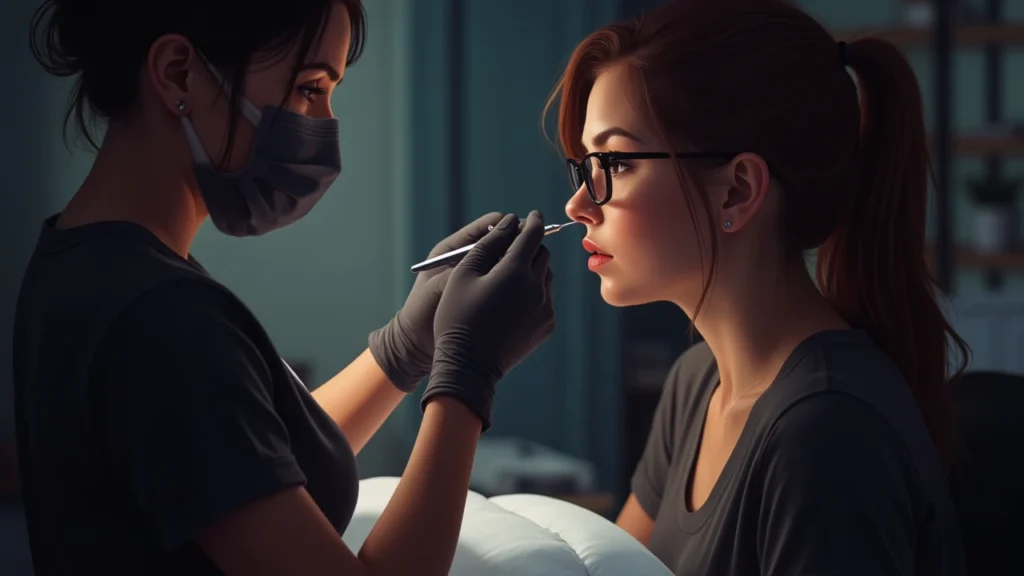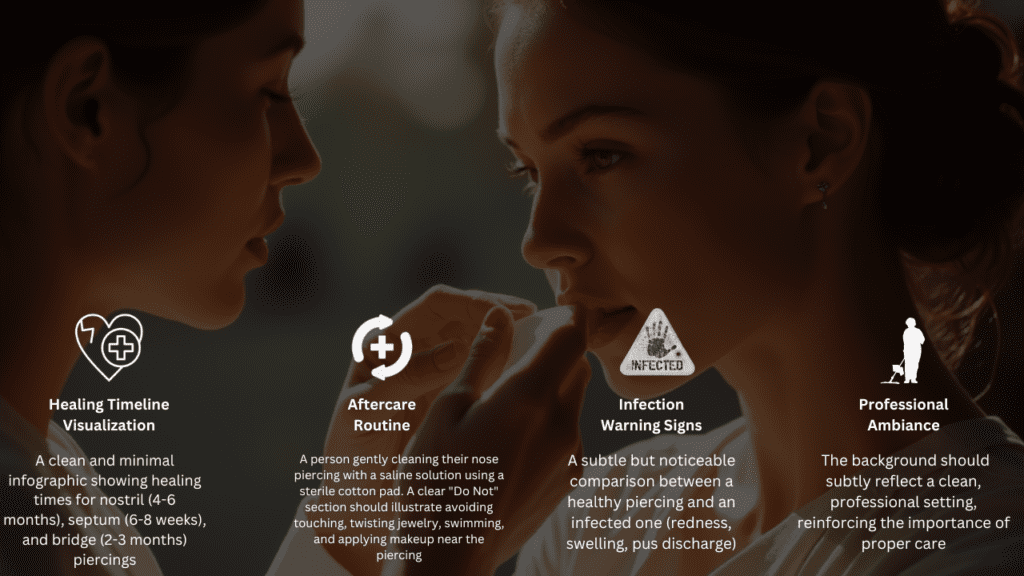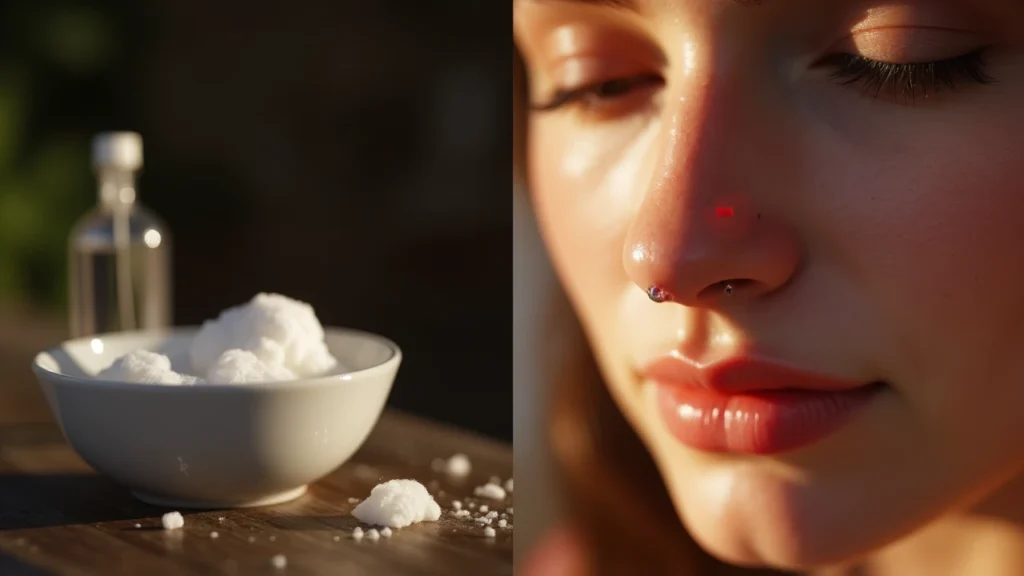Introduction
Nose piercings have been a fashion statement for centuries, and today, they are more popular than ever in the USA. As the second most common facial piercing, they seamlessly blend tradition with contemporary style. Whether you prefer the understated elegance of a stud or the bold statement of a hoop, it’s essential to understand the different styles, safety precautions, and proper aftercare before getting pierced. Whether for cultural significance, personal expression, or simply for aesthetics, a nasal piercing is a stylish and unique way to enhance your look.
But before you take the plunge, it’s essential to understand the process, healing time, and best aftercare practices. Here’s everything you need to know about getting a nasal piercing in 2025!
Why Choose a Nose Piercing?

Nose stud transcend fleeting trends, rooted in ancient South Asian traditions as symbols of status and beauty. Today, they serve as versatile markers of individuality. Key motivations include:
- Adaptability: A minimalist stud offers understated sophistication, while a septum ring projects boldness.
- Cultural Resonance: Many adopt piercings to honor heritage or align with global aesthetics.
- Reversibility: Unlike tattoos, piercings can be removed or concealed effortlessly.
Types of Nose Piercings

Understanding piercing variations ensures informed decisions:
1. Nostril Piercing
- Classic Placement: Single hole on the nostril’s side.
- Healing Duration: 2–6 months.
- Jewelry Options: Studs, hoops, or screw-style pieces.
2. Septum Piercing
- Edgy Aesthetic: Targets the nasal columella (soft tissue between nostrils).
- Practical Flexibility: Flip-up jewelry enables discreet wear.
- Healing Timeline: 6–8 weeks.
3. High Nostril Piercing
- Elevated Style: Positioned higher on the nostril for uniqueness.
- Healing Challenges: 6–9 months due to dense cartilage.
4. Bridge Piercing
- Daring Choice: Horizontal placement across the nose bridge.
- Risks: High rejection potential; unsuitable for novices.
5. Nasallang Piercing
- Extreme Statement: Pierces both nostrils and the septum in a single straight line.
- Bold and Rare: A unique, intense piercing for those seeking something out of the ordinary.
- Challenging Procedure: Not for the faint of heart!
Choosing the Right Nose Ring

Jewelry quality directly impacts healing and comfort:
Studs vs. Hoops – What’s Best for Healing?
- Studs are recommended for new piercings as they are less likely to get caught on clothing or hair.
- Hoops are stylish but should be avoided during the healing process as they move more and can cause irritation.
Best Materials for Nose Rings
- Titanium – Hypoallergenic and perfect for sensitive skin
- 14K/18K Gold – A classic, skin-friendly option
- Surgical Steel – Durable and safe for healing
Expert Tip: Begin with a basic stud; transition to decorative options post-healing.
Identifying a Reputable Piercing Studio

Searching for “Piercing studio near me” is a great start, but not all studios are equal. Avoid haphazard searches for “Piercing studio near me.” Prioritize the following:
- Review Analysis: Target studios with consistent 4.5+ ratings (Google/Yelp).
- Certification Verification: APP-affiliated studios adhere to stringent hygiene standards.
- Critical Queries:
- “Do you use sterilized needles or piercing guns?” (Needles reduce trauma and infection risk.)
- “May I inspect your autoclave certification?”
Cost Range: 30–30–80 in the U.S., varying by jewelry and location.
The Piercing Process: Step-by-Step

Anticipate the following stages:
- Consultation: Placement marking and jewelry selection.
- Procedure: Swift needle insertion (comparable to brow hair plucking).
- Jewelry Placement: Initial stud or hoop insertion.
Pain Assessment: Typically rated 3/10; manageable with controlled breathing.
Healing & Aftercare Tips

Negligence risks infections and prolonged recovery. Adhere strictly to:
How Long Does It Take to Heal?
- Nostril piercing: 4-6 months
- Septum piercing: 6-8 weeks
- Bridge piercing: 2-3 months
Best Aftercare Routine
- Clean with saline solution (avoid alcohol or hydrogen peroxide)
- Don’t touch or twist your jewelry unnecessarily
- Avoid swimming pools and makeup around the piercing
Infection Indicators: Throbbing pain, pus discharge, or excessive swelling warrant immediate medical consultation.
Common issues
Q: Can I conceal my piercing professionally?
A: Yes. Bioflex retainers offer transparent, non-metallic solutions for healed piercings.
Q: Will scarring occur?
A: Minimal scarring is typical with proper care. Keloid formation is rare but possible in predisposed individuals.
Q: When can I change jewelry independently?
A: Wait 2–3 months (nostril) or 6–8 weeks (septum). Initial changes should be performed by professionals.
Common Nostril piercing Problems and Solutions

Bumps and Keloids
A small bump may form due to irritation. Use warm saltwater soaks and avoid touching the area.
Infections
Redness, swelling, and pus indicate an infection. Clean thoroughly and consult a piercer if needed.
2025’s Hottest Nose ring Trends
- Curated Clusters: Double or triple studs on one nostril for a curated, edgy vibe.
- Metal Fusion: Mix rose gold, platinum, and textured silver hoops for bold contrast.
- Signature Charms: Tiny zodiac signs, initials, or nature-inspired gems for personalized flair.
- Stacked Nostrils: Dual studs on one nostril for contemporary appeal.
- Mixed Metals: Combine gold and silver hoops for dynamic contrast.
- Personalized Charms: Incorporate subtle crosses, gemstones, or initials.
Recommended Products
- Aftercare Essential: NeilMed Piercing Aftercare Spray
- Hypoallergenic Jewelry: BodyArtForms Titanium Studs
- Discreet Retainers: Painful Pleasures Bioflex Retainers
- Gold Nose Stud for Sensitive Skin – Click here
- Titanium Nose Ring for Healing Piercings – Click here
- Sterilized Nose stud Kit (For Professionals) – Click here
Conclusion
A Nose piercing merges artistry with self-expression, demanding meticulous planning and aftercare. By selecting certified studios, prioritizing hypoallergenic jewelry, and adhering to aftercare guidelines, you ensure a safe, stylish outcome.
Ready to shine? Schedule your appointment at an APP-certified studio and embrace a piercing that reflects your individuality. you’ll rock your new look with confidence.
FAQs
- Does a nose piercing hurt more than an ear piercing? – Slightly more, but it’s quick!
- Can I swim with a new Nasallang piercing? – No, avoid pools for 6-8 weeks.
- How much does a High nostril piercing cost in the USA? – $30-$80 on average.
- What happens if my Nose stud closes up? – It depends on healing time, but re-piercing may be needed.
- Is it okay to wear makeup around a new Nostril piercing? – Not recommended until fully healed.
Other Related Blog
And if you’re interested in learning more tips and tricks for everyday wellness, feel free to check out my other blogs—they cover a wide range of topics to help you feel your best, no matter the situation!
https://whimsyfy.com/best-watch-brands-luxury-to-affordable-under-1000/
https://whimsyfy.com/can-headphones-cause-hair-loss-science-prevention/


